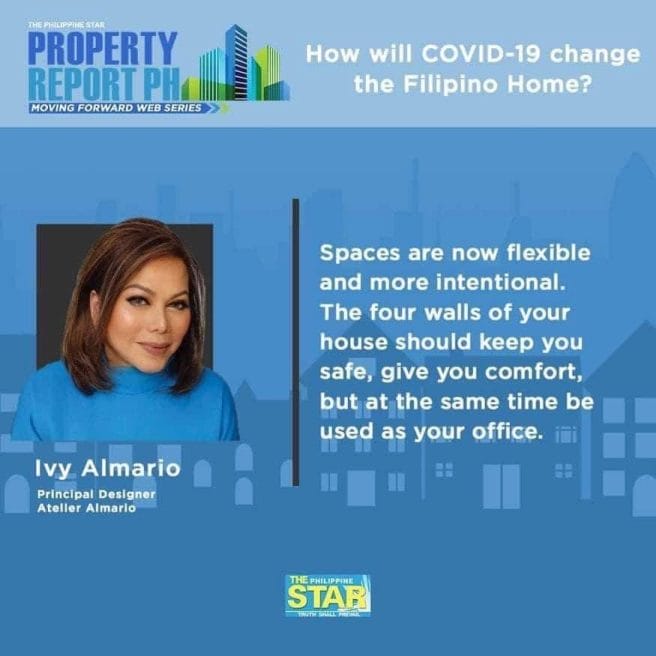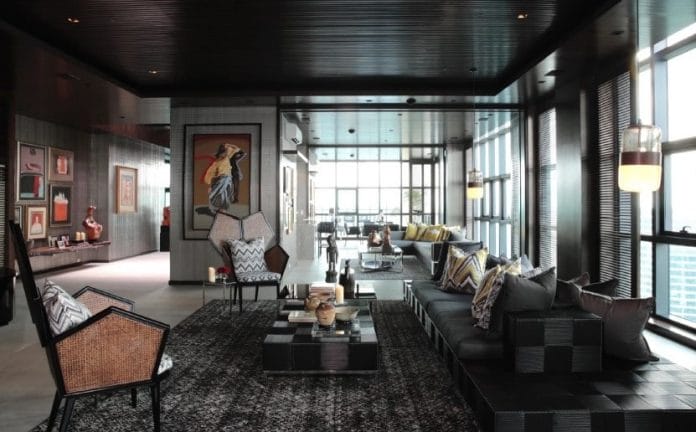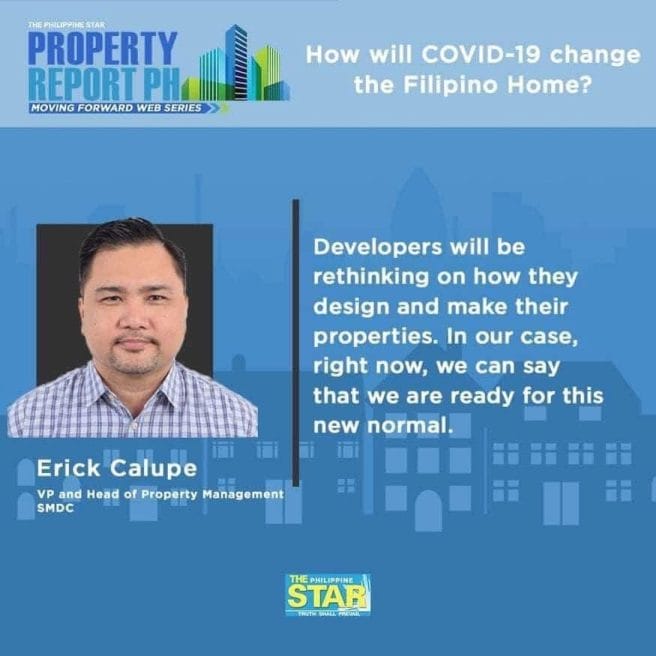Quick fixes, storage solutions, condo etiquette, and plants on facades of houses and buildings as discussed by designers Ivy Almario and Jason Buensalido, and property management head Eric Calupe.
To date, the Philippines has the longest quarantine period around the world. It has been three months and a half since the enhanced community quarantine (ECQ) was enacted by President Duterte; and in those months, people were cooped up in their homes to minimize the spread of the virus. People have realized that certain aspects of their homes — whether stand-alone houses or condominiums — could do with some improvements to make it more comfortable or respond to new needs. While no one could have foreseen the many changes brought by the COVID-19 pandemic, it has certainly made Filipinos change the way they view their homes and its functions.
This was the point of discussion in the second episode of Property Report PH’s webinar in the series Moving Forward with guests Atelier Almario principal designer Ivy Almario, Buensalido + Architects principal architect Jason Buensalido, and SMDC VP and head of Property Management Erick Calupe, and hosted by Property Report editor Tanya Lara.
CHANGES BROUGHT BY THE COVID-19 PANDEMIC
“The pandemic and lockdown are definitely a wake-up call, not only for designers and architects but also for planners and more importantly to the home owners themselves,” says Buensalido.
“For the first time in their lives, most of our clients were able to appreciate the time and investment that they put in to create homes that touched all the activities in their lives,” says Almario. “The lockdown allowed them to appreciate what’s within the house for all the activities that you could possibly do. The four walls of your house should keep you safe, it has to give you comfort, be cocooning and at the same time, can also be used as your office — very intentional na ngayon yung use.”


It is a slightly different scenario in a condominium development with a lot of common areas or shared spaces that promotes community living. “Based on our experience, when the lockdown happened there was a general sense of caution everywhere and the same was true in the communities that we develop,” shares Calupe.
“Maraming bagong (protocols) that we implemented and they needed a lot of adjustments from the end of the property management, and we monitor these on a daily basis. As soon as you enter the development, whether the parking lot or main lobby, you’re required to wear face masks or you will not be allowed to enter the building or be outside of your unit. You will also see a foot bath mat to disinfect your shoes and a temperature scanner to take your temperature, and alcohol for your hands for additional disinfection.”
“Our property management team is always there to hear from our homeowners, to give them assistance with their concerns and advise them, and give regular updates. There were several things that we did (for our residents), especially those who were living alone in their units, particularly those who were not allowed to out — those below 21 years old and senior citizens,” Calupe further shares.
“There are actually four programs that we implemented (during the quarantine), in cooperation with the condominium corporation. One of them was a weekend market that brought fresh produce to the development so that residents did not have to go out to buy produce and therefore minimize their exposure to the virus. We had a health and wellness caravan, especially for the elderly because some of them really needed a check-up but they could not go out. Another program is specific for the elderly and PWDs that live alone in their units, we made sure that food and medicine requirements were provided by offering personal shopping service. And last, was our program on mental health. So those are the things that we provided. Of course, a lot of our developments are near SM malls, so that’s another plus — everything they needed and the basics are near,” says Calupe.
QUICK FIXES DURING AND POST-COVID
With schools and offices shifting to online arrangements, Filipino families soon realized the need for a dedicated space in order to work and study. According to Buensalido, there are three ways for a home to be functional to address work from home and home schooling. First is to have an open plan. “People are saying that open plans will stop from existing because we need segregated spaces — separate dining area, separate living area and so on. I think if we have an open plan, you’ll be able to get a bigger space and able to move things around and adjust to the activity required for that specific day.”


“Second, if there is going to be any addition to (the) home design, it would be a multi-purpose room. Yes, you can co-exist in one space but sometimes you still need privacy especially visual and auditory privacy, for example, when you’re making a pitch, or there’s a private board meeting and then it’s time for home school,” he adds.
“If the space is not able to accommodate that addition, then the third way would be communication with your family or house mates ‘Hey, I have a board meeting today. Would you mind postponing that loud activity by another hour,’ or something like that.”

Almario says plants are also a good addition to the home. “One thing that I did na kayang-kaya kopyahin ng lahat, I introduced plants in the house. They give a boost to the space, you feel the air quality is better. And plants are alive, they give you positive energy,” says Almario.
Another probable solution is to add storage spaces to the home, especially for those living in condominiums — to store food items and other basic necessities. “When you maximize space, you can capture the corridors, the bed and put concealed storage,” shares Almario. “I think about the housewife who always says, ‘I want a big wardrobe.’ But would she still want a big wardrobe if she cannot go out with her friends or she no longer has to dress up every day? It’s a push and pull, kasi hindi naman lumalaki ang space footprint.

“Design is a three-dimensional kind of problem-solving…in terms of creativity and innovation, even if the footprint of your space (won’t) change, it will force us designers and homeowners to come up with creative and innovative ways to address the issue of storage.”
IS FUTURE-PROOFING HOMES POSSIBLE?
The Philippines has its share of natural disasters, and with the COVID-19 pandemic, many people began wondering if it was possible to futureproof their homes should another crisis loom in the near future. “The idea of futureproofing one’s home is quite difficult simply because nobody can see the future. But I do believe in the idea of resiliency and including the pandemic in the long list of things to consider for our homes. But we should not make the mistake of designing our homes to address only the pandemic or the issues that were highlighted during this pandemic,” says Buensalido.

“What we need to do is to take a second look at a long list of learnings that we’ve had from the Spanish flu, from the earthquakes, flash floods and then add the pandemic to that list and sort of create a solution that is adaptable or resilient, or at least able to respond to this long list while taking into consideration that it really should be about humane and livable spaces beyond disasters.”

In condominium developments, space considerations are being made by property developers. “For sure developers will be rethinking how they will design and build their properties. In our case, we can say that we are ready…but definitely it’s something that needs to be discussed,” says Calupe.
When it comes to innovations or new products as a result of COVID-19, many of today’s furnishings and home products were the result of previous crises and pandemics. Buensalido states that product designers will scramble to come up with innovations that will address the pandemic based on their research from labs and testing facilities. For designers and architects, however, they do not need to look far to come up with solutions to address the pandemic. “Building on what Ivy said about plants, we don’t need to look far to come up with solutions to address these things. Plants could also be used as a material for the façade. If you go to other countries like Taiwan or Madrid, vertical gardens are already being used as building material. There’s also the idea that whatever you get from the land, you have to at least replace with some form of vegetation,” adds Buensalido.
* * *
If you missed the webinar, visit Property Report PH’s Facebook page.
